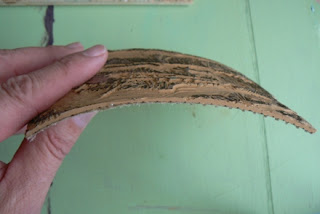With tools purchased some months ago, a "snow day" at the beginning of the work week, an eraser, the back of a cradled support, jazzy music, warm stocking feet, and hot cocoa....I try my hand at a lino cut.
Pencil drawing on lino pad based on ABOVE photo. Next, went over the pencil drawing with thin Sharpie marker.
Cutter tip loaded into the cutter handle after loosening the chuck. Followed directions: After securing the blade in the handle, position your forefinger as close as possible to the cutting edge. As a safety precaution while cutting the block, position the hand holding the block behind the hand holding the tool. Apply even pressure, and ease off when completing the cut, It is not necessary to dig deeply into the block.
Eight minute video. Click on the X of the Google ad when it appears, and the ad will disappear.
Click on 3 minute video tiny cuts.
The inking portion did not seem so exciting to me. Not able to find a glass pane I improvised with aluminum foil.click here for 5 minute video inking lino pad. Decided to roll water soluble acrylic paint out with brayer on aluminum foil.
Turquoise Speedball water soluble ink printed on dry typing paper.
Here is same print on black paper.


Used bristle scrub brush, soap, and water to vigorously wash off ink on lino pad.
After drying with clean cloth, the linopad want to warp -- so I sandwich the pad between two layers of paper towels on the table. Then I pile a couple heavy books on top and leave it to dry overnight. In the morning the pad is dry and flat.
I am exactly like anyone else who has not tried a new medium before. I do not know what my efforts are going to look like. I see the results and immediately hate what I see and want to throw it away. Inspite of my feelings my wife tells me it looks good. Well.... I must follow the same advice I hand out to any beginner. "Put the artwork aside, sneak looks at it from time to time, and let it grow on you." I will tell you this much--I enjoyed cutting it more than printing it. I want to try another one. And I certainly have gained a better understanding of the process myself. Now when I look at a linocut by another, I know more of the work that went into a piece.
Route E Snow, linoleum pad, 4 by 6 inches (above) Last impression (below)
After looking at the print over a couple weeks, I went back in and cleaned up the image. I like it better now.
Route E Snow, linoleum pad, 4 by 6 inches (above) Last impression (below)
After looking at the print over a couple weeks, I went back in and cleaned up the image. I like it better now.






























